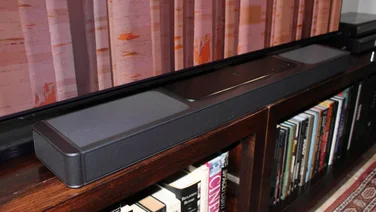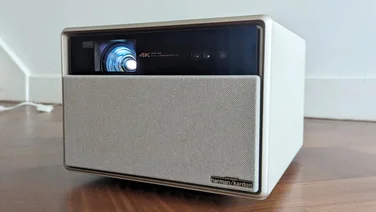To help us provide you with free impartial advice, we may earn a commission if you buy through links on our site. Learn more
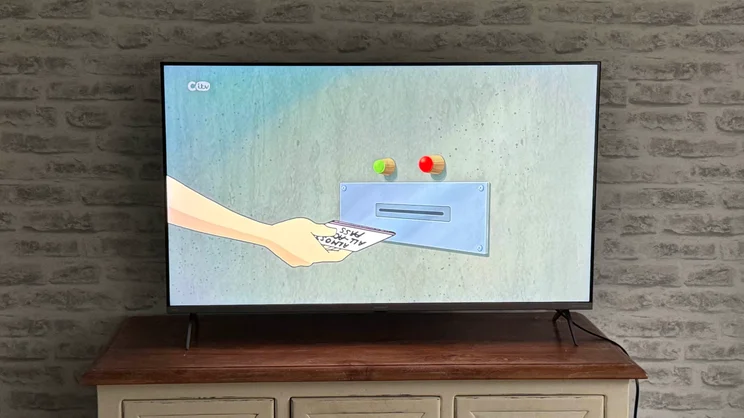
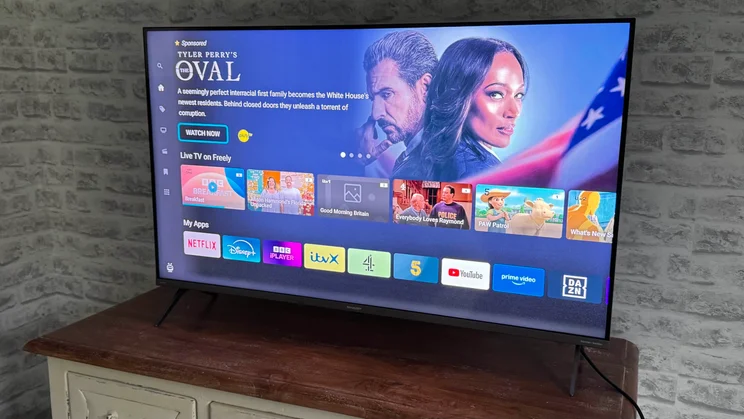
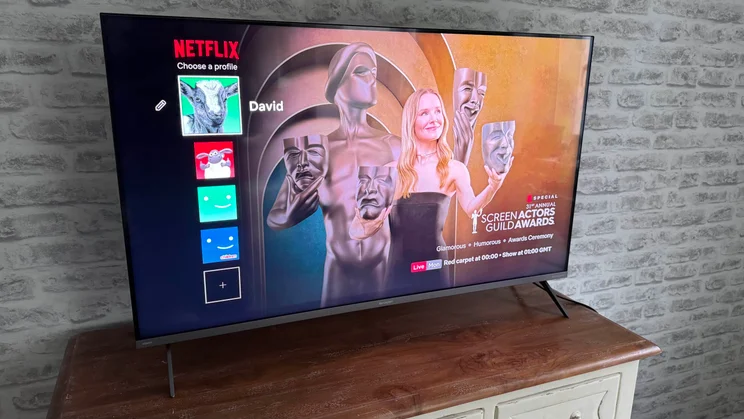
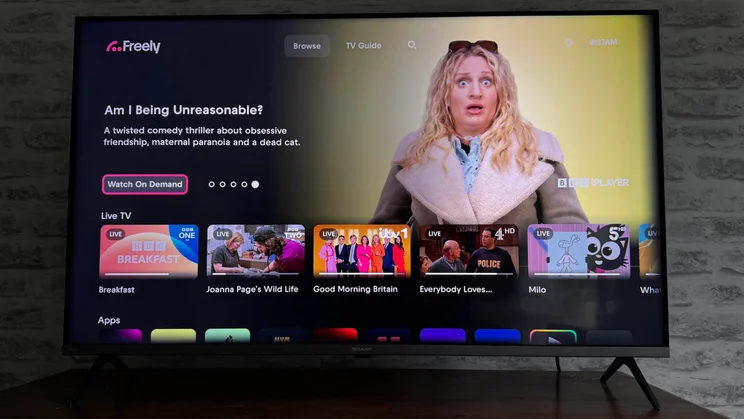
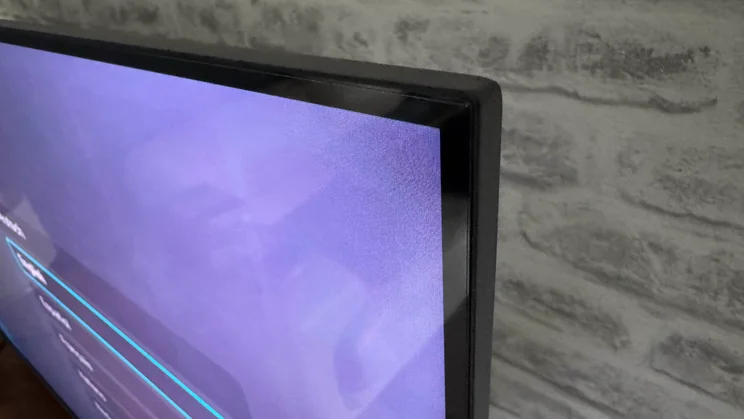

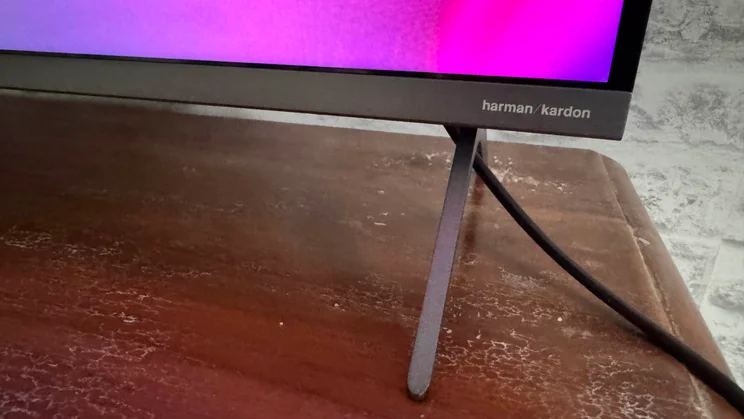
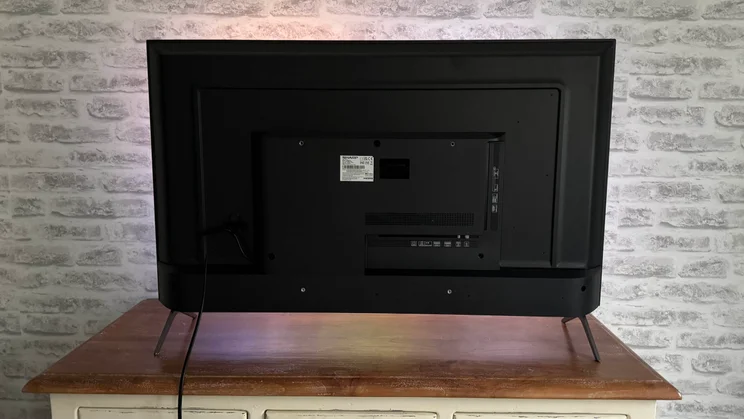
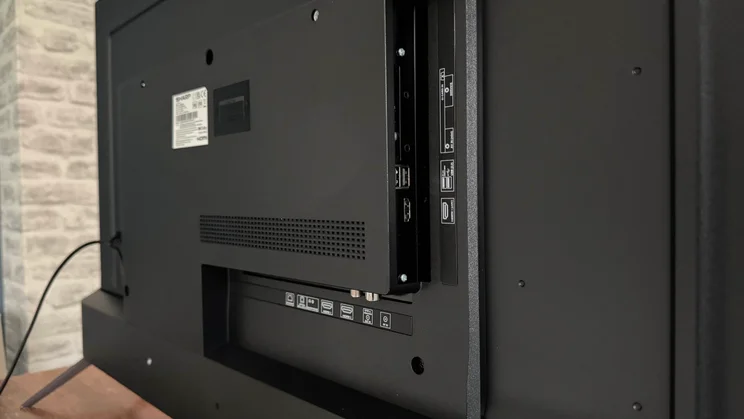
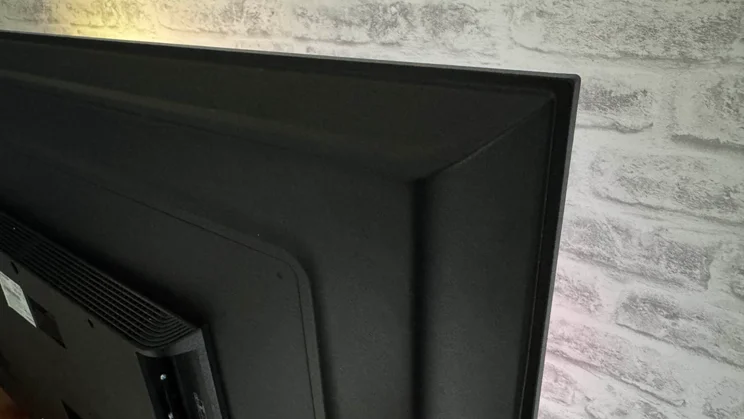
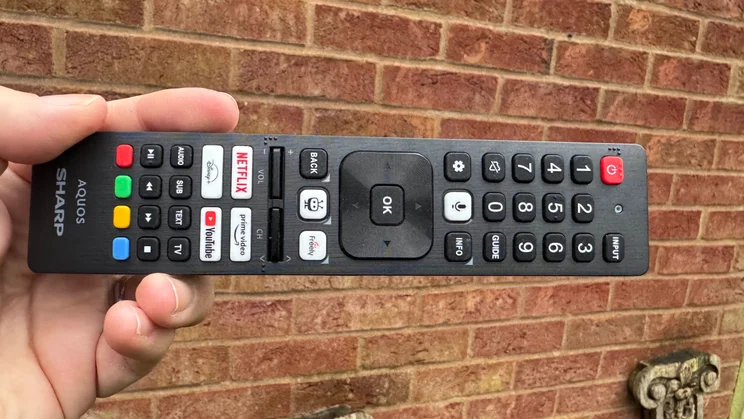
- TiVo and Freely smart system support
- Good picture quality for the money
- Great value
- Plasticky, lightweight construction
- Lack of refinement with dark colours
- Not much for gamers to get excited about
At first glance, Sharp’s GM6 TV looks like just the latest in a long line of determinedly basic budget TVs. Its bodywork looks and feels plasticky, its connections are somewhat basic, and it doesn’t offer much for gamers to get their teeth into. The more time you spend with a GM6, though, the more you realise there’s much more to this unassuming-looking range than first meets the eye.
Sharp GM6 review: Key specifications
| Screen sizes available | 43in 43GM6245K, 50in 50GM6245K and 55in 55GM6245K |
| Panel type | VA-type Quantum Dot LCD, with direct LED lighting |
| Resolution | 4K/UHD (3,840 x 2,160) |
| Refresh rates | Up to 60Hz |
| HDR formats | HDR10, HLG, Dolby Vision |
| Audio enhancement | 2 x 12W Harman Kardon speakers, Dolby Atmos decoding |
| HDMI inputs | 3 (1 x eARC) |
| Freeview Play compatibility | No, but carries Freely instead |
| Tuners | Terrestrial Freeview HD |
| Gaming features | ALLM, dedicated Game menu |
| Wireless connectivity | Bluetooth, Wi-Fi |
| Smart assistants | TiVo Voice recognition |
| Smart platform | TiVo and Freely |
What you need to know
The GM6 series is a relatively small-screened range of TVs aimed at the budget/potentially second room end of the market, trading build quality, gaming features and style for an aggressive price.
In keeping with a growing number of budget TVs, however, the GM6 relies on a third-party smart TV system, in this case TiVo, to provide easy access to an impressively wide range of online content.
Price and competition
The pricing of the Sharp GM6 series fluctuates more than most. At the time of writing, Sharp has the 43in model I’m reviewing here listed for £330, but you can pick one up for just £199 from Very. Meanwhile, the 50in model will set you back £279. I’ve not been able to find 55in option in stock anywhere, but the largest entry in the range has a list price of £499.
Rivals offering a similar combination of advanced smart features and aggressive pricing include Amazon’s Fire TV Omni QLED and the Bush UT24SB. Amazon’s QLED alternative costs more than the Sharp GM6 across its four sizes (the 43in option is priced at £360) but adds HDR10+ to the feature count, while the 43in, 50in and 55in iterations of the UT24SB cost £159, £219 and £269, respectively.
Design, connections and control
The GM6’s build quality is flimsy, featuring lightweight plastic throughout. This does have the advantage, though, of making the 43in model very easy to move between rooms.
From a typical viewing distance, the GM6 hides its plasticky nature behind a crisp combination of a grey tone for the screen’s bottom edge and black for the other three sides. The left, right and top edges are pleasingly slim for such an affordable TV, too.











The slenderness does not extend to the GM6’s rear, though, which is fairly chunky by today’s standards, making it a slightly cumbersome wall mounting option. Most users will probably stick the screen on its provided feet, though. Especially as these look quite smart in their gleaming finish and sleek blade-style design.
The GM6’s connections are solid for such an affordable TV. Three HDMIs lead the way; one less than you get with most mid-range or premium TVs, but enough for most households’ needs and pretty much par for the budget TV course. Joining the HDMIs are a pair of USB ports, an optical digital audio output, a wired headphone connection, and, unusually for a 2025 TV, mini line inputs for composite video and stereo audio sources.











The GM6 ships with a bog-standard remote control that’s a bit overcrowded and, like the TV it accompanies, feels flimsy and light. It does at least provide a decent selection of direct app access buttons, though.
Smart TV platform
Its combination of TiVo and Freely smart systems gives the GM6 access to a remarkably comprehensive suite of streaming apps and features. TiVo provides access to most major global players, including Netflix, Prime Video, YouTube, and Disney+, but there’s no direct access to Apple TV+, Discovery+ or Paramount+. These can be accessed through Prime Video, however.
TiVo’s long history of developing advanced content search and recommendation tools for TV users also means the GM6 benefits from a very clear, easy-to-follow and engaging onscreen interface, unusually helpful content suggestions, and one of the most natural and far-reaching voice recognition systems in the TV world.











The GM6’s Freely app, meanwhile, provides UK users with access to not only live-streamed versions of most of the main channels broadcast on the Freeview HD platform, but also tens of thousands of hours of on-demand content. The Freely interface is slick and appealing, and switching between the TiVo and Freely smart ‘cores’ feels seamless and logical.
Image quality
The GM6 gets off to a great start by delivering seriously watchable SDR images. Its VA panel and direct lighting contribute to surprisingly satisfying black levels, and the screen avoids the major grey wash of glowing effect issues often seen at the cheaper end of the TV market. The above-par black levels remain intact from a slightly wider viewing angle than I expected from such an affordable VA-type LCD panel.
In the GM6’s Movie preset, the good black levels are joined by a 151cd/m2 white level that fits with the luminance associated with accurate SDR pictures, ensuring that no brightness highlights or colours look exaggerated.
My Calman measurements showed the TV to be pretty accurate by budget option standards. Multipoint greyscale, ColorChecker, Saturation Sweep and Luminance Sweep measurements came in at 6.3, 4.3, 4.1 and 4.1, respectively, which aren’t too far from the visible threshold of three.











So it’s not surprising that my subjective impression of the SDR Movie mode’s colours was that they look consistently balanced and believable, as well as containing good levels of tonal subtlety and blend control. The screens cover more than 98% of the Rec709 colour spectrum, too.
More surprising is how well colours hold up if you stick with the GM6’s default Natural picture setting. This more than doubles the SDR white level to 370cd/m2, and also more or less doubles the level of colour and greyscale errors recorded by our Calman tests. But actually, the Natural mode picture still looks balanced and nuanced enough to remain credible, making it a good option for bright rooms.
While the GM6 is far from the brightest LCD TV I’ve seen, it delivers a good sense of contrast in SDR without suffering significant clouding or inconsistencies in the darkest areas. It does a solid job of upscaling HD pictures to their native 4K resolutions, too, avoiding the common budget TV pitfall of exaggerating source noise while also not leaving upscaled pictures looking soft or processed.











And with native 4K SDR sources (if you stumble across such a relatively rare combination these days), this budget TV series looks exceptionally crisp and detailed. This crispness doesn’t take as much of a hit as expected when there are significant amounts of motion to handle, either, even with 24 frames a second films. It’s tough to find anything bad to say about the GM6’s SDR pictures, given how affordable these TVs are.
HDR performance
Let’s establish some context for the GM6’s HDR performance right away by saying that Calman tests reveal that it tops out at 380cd/m2 on a 10% HDR window in Natural mode. This drops to around 180cd/m2 on a 1% window.
On the upside, in both its Natural and Movie presets, the GM6 sustains the brightness peaks that kick in at the 10% window size (this peak is 350cd/m2 in Movie mode) through to a full-screen (100%) HDR test pattern. So most HDR images are delivered with good brightness consistency.
While getting close to 400cd/m2 with HDR content isn’t a bad brightness result for a TV as affordable as the GM6, it’s a mile away from the brightness being delivered by some premium Mini LED and OLED TVs. But as more evidence of how effectively Sharp’s GM6 uses what brightness it has available, tests show it capable of covering a very impressive 95.27% of the DCI-P3 colour spectrum used in most HDR mastering, as well as 76.29% of the much larger BT.2020 gamut.











Even with HDR, the GM6’s Movie mode keeps the Delta E 2000 error to under 6 for both Calman’s ColorChecker and Multipoint Greyscale HDR tests; a better result than some mid-range and even a few premium TVs achieve.
Watching the GM6 in action with HDR content delivers subjective results that tally nicely with the combination of the measurements I obtained from the TV and the core picture qualities revealed by its SDR performance. So while HDR pictures might not be spectacularly punchy by the standards of the TV world in general, they are brighter than those of many similarly affordable TVs. The brightness also feels enhanced by the GM6’s ability to present impressively deep and consistent black colours despite the extra brightness that HDR brings to the table.
Good levels of shadow detail in dark scenes suggest that the GM6’s black level talents are quite native and natural to the panel rather than being forced by aggressive light controls.
The issue noted from my Calman tests, where very small bright HDR highlights aren’t as bright as larger HDR areas, is noticeable to the naked eye, but this small highlight dimming always happens ‘between cuts’ rather than within a shot, so it’s not very distracting.











Colours look amplified and bold in HDR compared with SDR, especially if you can feed the TV a Dolby Vision master, yet HDR images still usually maintain natural-looking tones that feel in balance with each other. The extra light and colour range the GM6 shows with HDR footage amplifies the sense of clarity, polish and detail the GM6 achieves with native 4K content. Motion looks a fraction softer with 24p HDR sources than it does in SDR, but still outguns most other similarly affordable TVs in this key picture area.
Limited brightness isn’t the only flaw or limitation of the GM6 revealed by the extra challenges associated with HDR content. Very occasionally, I noticed a faint pink undertone creeping into some bright shots. And, while dark areas within the main image are always convincing, the black bars you get above and below films shot using aspect ratios wider than the TV’s 16:9 screen can grey out a bit distractingly if the images between the bars are particularly bright.
My main complaint about the GM6’s HDR pictures is that in very dark shots, colour tones can start to look a bit rough and less detailed. At no point, though, did I ever come away from a film or TV show watched on the GM6 feeling anything less than impressed overall by the picture quality I’d just enjoyed from such an affordable TV.
To test the Sharp GM6, I used Portrait Displays Calman colour calibration software.
Gaming
In feature terms, the GM6 could not be considered a gaming TV, as it doesn’t have all that much going on to excite gamers. Its screen is a resolutely 60Hz affair, with no fancy processing tricks available that might enable it to step up to 120Hz or higher gaming support. There’s no support for variable refresh rates either.











The HDMI ports do support Auto Low Latency Mode switching, though, so the TV will switch into its fast-response game mode automatically when a game source is detected. In this Game mode, the screen reduces the time it takes to render images to a respectably low 15ms.
The TV also supports HDR gaming, including in the Dolby Vision format, without adding lots of extra lag to the image rendering process. Given this, it’s not surprising that gaming feels responsive and fluid on the GM6 despite its limited refresh rate support. The same sharpness, rich-but-controlled colours and good contrast strengths that illuminate its video performance versus most similarly affordable rivals also deliver an enjoyable gaming spectacle. Even if I did find the screen’s tendency to limit the intensity of very small bright highlights a bit more noticeable with game graphics than it is with video.
Sound quality
The 2 x 12W Harman Kardon-designed speaker system deployed by the GM6 joins its picture engine in outperforming the TV’s price point.
Separating the bass/mid drivers from the treble ones does as hoped, helping the TV deliver plenty of detail. The speakers can also pump out enough raw volume to make movies sound like movies, as well as push sounds far enough clear of the TV’s bodywork to create quite a large soundstage.











The combination of clarity and a large soundstage even means the GM6 can do some justice to the Dolby Atmos soundtracks it’s capable of decoding, while vocals sound clean and intelligible at all times without sounding too bright or detached from the rest of the sound.
Female voices and high treble sounds can sometimes sound a bit shrill, and the lack of a dedicated subwoofer means that bass feels a bit lacking at times, denying action scenes the sort of heft we’d like them to enjoy. Overall, though, the GM6’s sound continues the theme of delivering more than you’ve any right to expect for so little money.
Verdict
Sharp’s GM6 is a great budget TV, with its wide-ranging and slickly delivered TiVo/Freely smart features immediately making it a strong second-room option.
However, its surprisingly punchy and refined pictures, and clean, detailed Harman Kardon-influenced sound end up making it a potentially winning main living room TV too.



